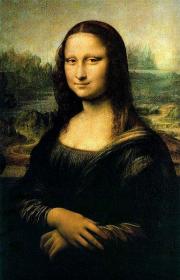 Italian scientists hope to dig up the remains of Leonardo da Vinci in order to determine if his most famous painting, the Mona Lisa, is a disguised self-portrait.
Italian scientists hope to dig up the remains of Leonardo da Vinci in order to determine if his most famous painting, the Mona Lisa, is a disguised self-portrait. Traditionally, the individual in the painting is thought to have been Lisa del Giocondo, the wife of wealthy Florentine silk merchant. However, speculation surrounds the true identity of the individual, with several other women (including da Vinci’s mother) being candidates.
Scientists seeking permission to exhume the remains of Leonardo da Vinci plan to reconstruct his face to discover whether his masterpiece, the Mona Lisa, is a disguised self-portrait.
A team from Italy"s National Committee for Cultural Heritage, a leading association of scientists and art historians, has asked to open the tomb in which the Renaissance painter and polymath is believed to lie at Amboise castle, in the Loire valley, where he died in 1519, aged 67.
Giorgio Gruppioni, an anthropologist, said the project could throw new light on Leonardo"s most famous work. “If we manage to find his skull, we could rebuild Leonardo’s face and compare it with the Mona Lisa,” he said.
The identity of the Mona Lisa has been debated for centuries, with speculation ranging from Leonardo’s mother to Lisa Gherardini, the wife of a Florentine merchant.
Recreating Leonardo"s face could test the theory of Lillian Schwartz, an American expert who drew on computer studies to highlight apparent similarities between the features of the Mona Lisa and those of a self-portrait by the artist.
Talks about the exhumation with French cultural officials and the owners of the chateau have resulted in an agreement in principle, according to the Italian team, and the project could receive formal permission this summer.
The church in which Leonardo was buried was destroyed after the French revolution of 1789. The remains were reburied in the castle’s smaller chapel of Saint-Hubert in 1874, beneath an inscription that describes them as “presumed” to be the master’s.
Silvano Vincenti, head of the Italian team, said its first step would be to verify that the remains are Leonardo’s. They will use carbon dating and compare DNA samples from the bones and teeth to those of several male descendants buried in Bologna, central Italy.
“There are not any clues in the history books, but we’ll be able to find out if Leonardo died of a disease such as syphilis or tuberculosis, because that shows up in the bones. Syphilis was seen as a form of plague at the time: some 20m people died of it in the first quarter of the 16th century,” Vincenti said.
Bone tests could also establish whether Leonardo suffered from lead poisoning, as did many fellow-painters of the time, because they were exposed to toxic pigments.
However, the plans have provoked criticism from Leonardo scholars who regard the notion of a self-portrait as a myth and who believe his remains should be left alone.
Nicholas Turner, a former curator of drawings at the Getty Museum, said: “It sounds a bit fanciful, slightly mad, as if the Leonardo bug has taken hold too firmly in the minds of these people. We know that Mona Lisa was a specific person, she existed and it’s her portrait. If Leonardo heard about all this, he’d have a good chuckle.”

 Previous page
Previous page Back to top
Back to top







